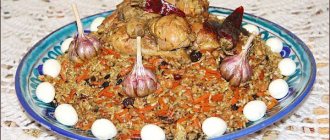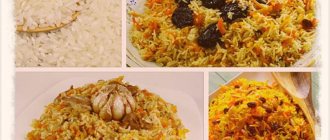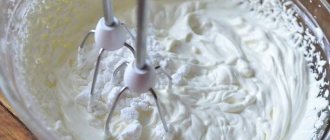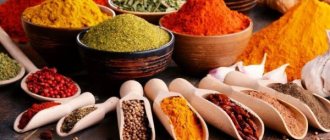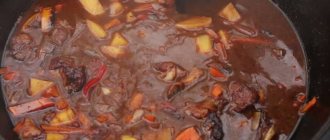Real Uzbek pilaf is crumbly rice of a pleasant golden color, large pieces of meat laid out around it and spicy spices that highlight the taste of the dish. It is not always possible to prepare it at home. Firstly, this requires a thick-walled cauldron, and secondly, it is recommended to cook it in the open air. Well, in general, the success of this dish of oriental cuisine largely depends on how correctly the zirvak is prepared. What it is, how and how much to cook it, we will tell you in our article. Let us dwell in more detail on spices for pilaf and other nuances on which the taste and aroma of pilaf directly depend.
What is zirvak?
In the East, it is believed that the most important part of pilaf is rice. It should remain crumbly in the finished dish, so you should choose only varieties with a low starch content. Yes, rice is really important. But the basis of real Uzbek pilaf is zirvak. A photo of this part of the dish is presented above. It takes much longer to cook than it takes to cook rice. So what is zirvak? How should it be cooked correctly to make the pilaf tasty?
Zirvak is a thick gravy, or rather a “pillow,” of vegetables and meat with spices, on which pre-soaked and washed rice is laid out. This part of the pilaf can be cooked in advance and then used to prepare the dish itself. In the original, zirvak is made with melted fat tail fat, in which first the meat, and then the onions and carrots are fried until golden brown. Then all the ingredients are poured with water and stewed with spices for a certain time. Rice is poured into the finished zirvak.
Main Ingredients
Traditional Uzbek pilaf:
- Meat - 400 grams (you can add another 100 grams, the amount depends on your preferences) They use lamb, but sometimes they add beef.
- Rice – 400 grams (should not contain too much starch, otherwise the rice will stick together).
- Carrots – 300 grams.
- Vegetable oil - about one quarter cup.
- Onion – 1 head.
- Garlic – 1 head (all cloves will be needed).
- Salt - add to taste. How much to add depends on your preference (keep in mind that rice will absorb a lot of salt, so add more) about 0.5 tablespoons.
- Jeera - the amount is usually indicated on the spice package.
- Barberry - 1 tablespoon.
Pilaf with chicken:
- Chicken fillet – 3 trays.
- Rice – 0.5 kilograms.
- Carrots – 1 kg.
- Large onion – 1 pc.
- Garlic – 1 head.
- Salt - again to taste.
- Vegetable oil – 1 cup.
- You can also add dogwood, cumin and barberry as seasonings.
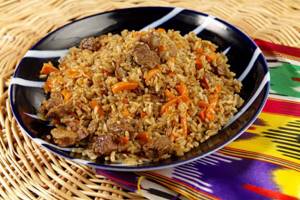
Russian pilaf:
- Pearl barley – 300 grams.
- Champignons – 200 grams.
- Black pepper – 1 teaspoon (more is possible).
- Carrots – 1 large.
- Onions – approximately 100 grams.
- Vegetable oil – 1 cup.
- Salt - to taste.
No spices are added!
Pilaf with meatballs:
- Rice – 200-300 grams.
- Minced meat – 450 grams.
- Water – 5 multi-bowls.
- Carrots – 1 large.
- Turmeric – 1 teaspoon.
- Onions – 2 heads.
- Salt - to taste.
- Vegetable oil - its function is to fry the meatballs.
Cooking recommendations
Experienced chefs have several useful secrets for preparing this dish:
- Ideal pilaf can only be cooked in a cauldron. In such dishes, the heat spreads evenly and the heat lasts longer. At home, you can use a cast iron casserole dish or a regular pan with a thick bottom and walls.
- You can prepare real Uzbek pilaf from lamb or beef. Be sure to leave the fat tail fat in the pan, which will give the dish a specific note. As for a certain part of the meat, it is better to use the hind leg for pilaf, cutting out all the tendons from it.
- For zirvak, you need to take the same amount of carrots as meat. The vegetable should be cut into thin slices. Grated carrots are not suitable for zirvak.
- Water also affects the taste of the pilaf base. It is recommended to take filtered or bottled. Moreover, it should be used both for zirvak and for soaking rice.
List of ingredients
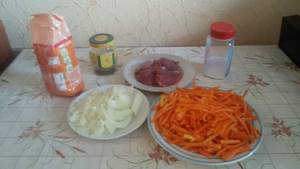
When all the secrets are revealed, you can start preparing the correct zirvak for Uzbek pilaf. It is recommended to purchase products on the market, and immediately for a large company. The aroma during the cooking process is such that all the neighbors will definitely come running to the smell. The list of ingredients consists of the following products:
- tail fat (mutton fat) – 500 g;
- lamb – 1.5 kg;
- onion – 700 g;
- carrots – 1.5 kg;
- vegetable oil – 500 ml;
- garlic – 3 pcs.;
- salt;
- spices.
Contrary to popular belief, meat in pilaf is not the main product. It definitely won’t ruin the dish. There shouldn't be too much of it. Excess meat interrupts the taste of spices and vegetables. The resulting volume of zirvak will be enough to prepare pilaf from 1 kg of rice.
LiveInternetLiveInternet
Quote from Troyan_95 message
Read in full In your quotation book or community!
When an Uzbek has money, he eats pilaf. Uzbeks say they know about 130 varieties of Uzbek pilaf. Let's consider one of them.
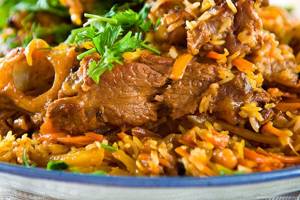
There are a lot of different recipes for pilaf. It is different in every region of Uzbekistan and even in every city. Moreover, everyone who prepares pilaf has their own techniques and tricks.
To prepare the Tashkent version we will need: 2 kg of fatty lamb, 2 kg of rice, a kilogram of red and yellow carrots, 2 kg of onions, raisins, barberries, soaked peas, cumin, ground red pepper...
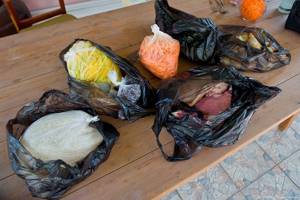
Wash the rice. Just fill it with water and leave it alone until we need it.
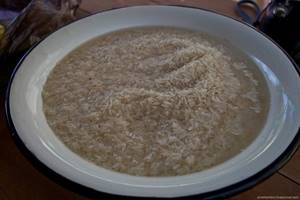
We take the meat and cut it into decent sized pieces. The meat should be fatty. Usually they take 1 kg of meat for 4-5 people. We didn’t eat even half of that 2 kg pilaf.
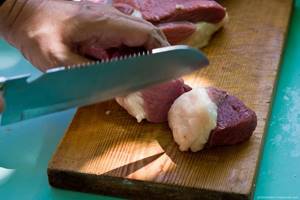
We had a small wood-burning cauldron. They say that it is important that pilaf is cooked on wood.
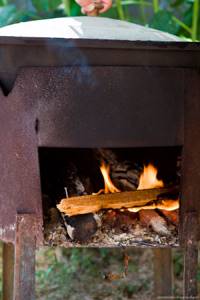
Pour oil into the cauldron and let it heat up.
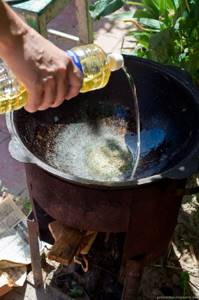
Cut the onion at least in half. You won’t find even a hint of onion in the finished pilaf - it will completely “dissolve”, leaving only the taste.
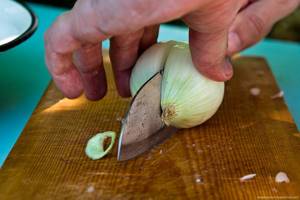
Add onion to hot oil. Everything starts to rustle.
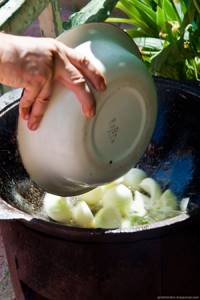
Meat goes there too.
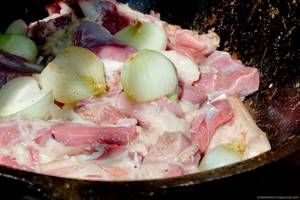
Soaked peas. It is already sold in this form at the market.
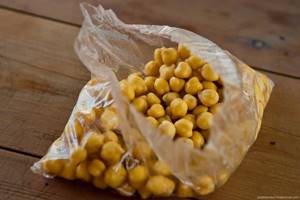
We also add it to the meat and onions in the cauldron. There are also barberries and peppercorns.
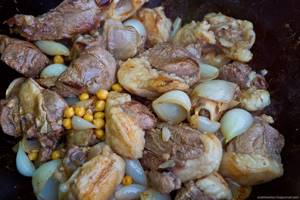
While this is all fried, you can have a small snack.
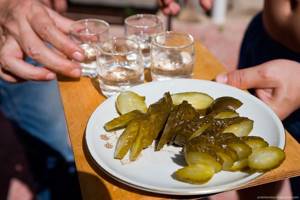
After the meat, onions and peas are fried a little...
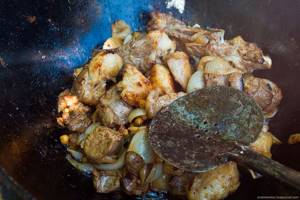
...fill them with water. It is important not to miss the moment and not to overcook - dry out the meat.
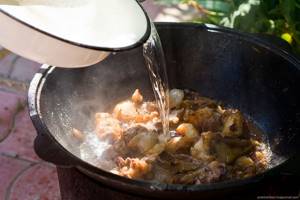
We leave it all to simmer and have a few more snacks and talk about philosophical topics.
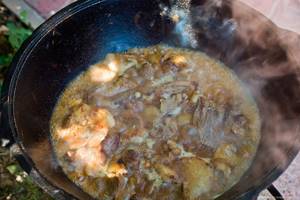
For seasonings for pilaf we need: cumin, red sweet pepper, red hot pepper and ground cilantro seeds.
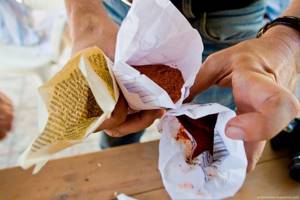
Cilantro seeds and a few whole heads of garlic.
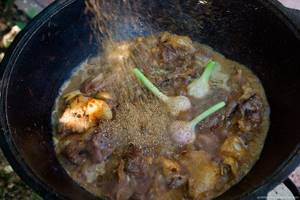
Ground red pepper.
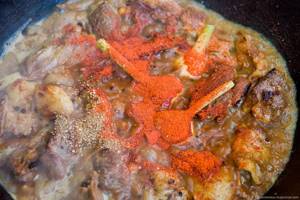
Add the already chopped yellow carrots.
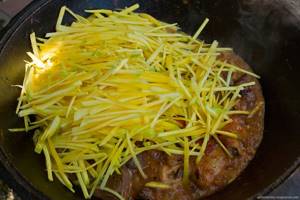
And add red.
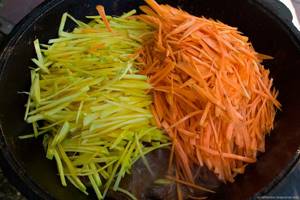
Some people also fry the carrots before adding water. But this is not our case.
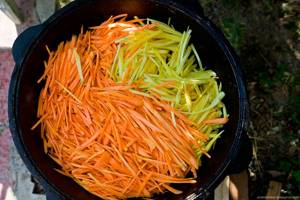
Now drain the water from the rice.
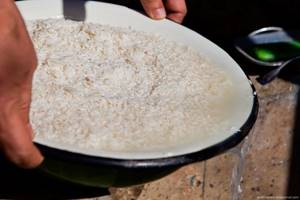
And pour the rice into the cauldron.
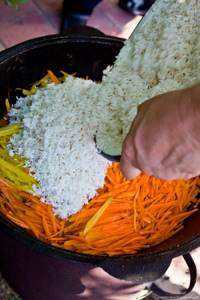
There should be enough rice so that it covers the entire contents of the cauldron with a fairly thick layer.
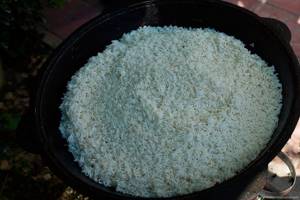
One of the most beautiful moments is when we add color to rice and pilaf in general. We fall asleep with zirchava. It is prepared from the root of some Indian plant or saffron is ground (there is a suspicion that it is just a dye with chalk).
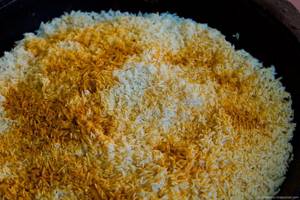
..and raisins. Yes, the stalks of the raisins had to be torn off, as we later noticed, but we ate them with the stalks too.
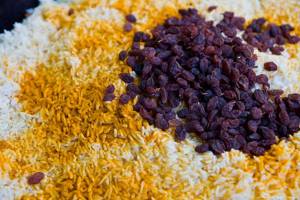
Add more ground pepper and cumin.
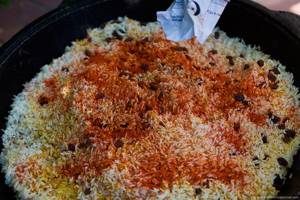
These striped seeds are cumin.
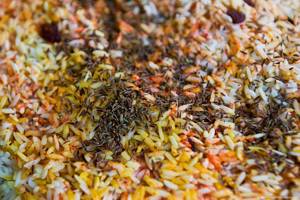
The rice is carefully stirred from time to time, but not mixed with the carrots and what is underneath.
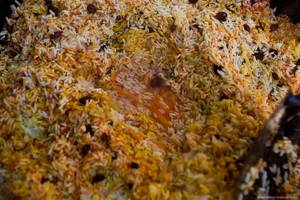
By the way, grape leaves are also sometimes added to pilaf.

We wait until the rice swells with steam.
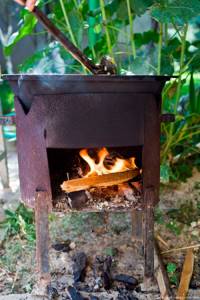
Meanwhile, we are cutting salad while having philosophical conversations.
As soon as the rice stops squeaking on your teeth when you try it, you can lay it out.
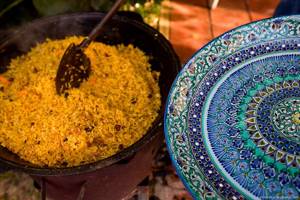
Be sure to serve in a Rishtan plate.
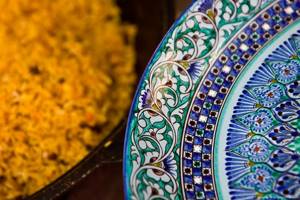
Don't drool all over your keyboard.
Source: fresher.ru
A couple more secrets of another Uzbek pilaf recipe...
We cut carrots. It must be cut into large strips. Under no circumstances should you grate or buy already thinly sliced carrots from which Korean salads are made. Secret No. 1 Thin carrots will disappear in the pilaf during cooking, which is unacceptable!
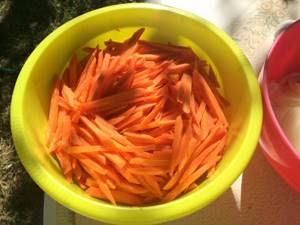
Cut the onion into rings. You can't get too worked up about this. Just know that the thinner you cut the onion, the faster and more intensely it will cook. It is easier to burn thinly sliced onions than coarsely chopped onions, and burnt onions in pilaf are at least not beautiful (and not tasty).
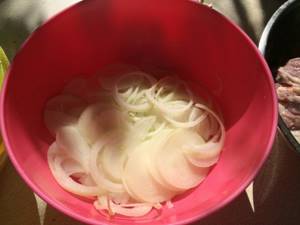
Wash and cut the lamb into pieces. This also has its own peculiarity. If you cut the pieces too finely, the meat will not be visible in the pilaf. It will just be rags everywhere. It is better to cut into pieces the size of half a palm or even a little more. If you bought ribs, they should be pieces of several ribs. It's better to buy the back leg. There is plenty of meat there, and there is a bone (according to tradition, the largest bone with a piece of meat is given to the eldest at the table or to the most dear guest). When buying meat, do not forget to ask for it to be cut into pieces.
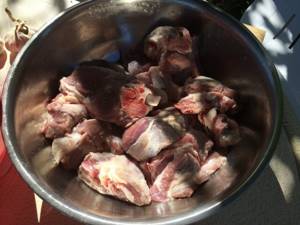
Trim the fat from the meat and cut it into small cubes. If you bought lean lamb, it is better to ask the seller for a piece of fat tail. We also cut it into cubes.
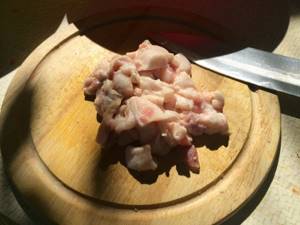
Pilaf can be cooked either on a gas or electric stove (on an electric stove it is more difficult and requires some skill, but it is impossible to cook pilaf on an induction stove), or on an open fire (hearth), but only in a cauldron!
No pots, enamel basins or buckets! This is pilaf, not army porridge. There are some secrets and features when cooking pilaf over an open fire. Secret No. 2
Firstly, the cauldron should be rounded towards the bottom. If the cauldron has a nickel (for the stove), then the pilaf in this place will burn. Secondly, prepare firewood and wood chips in advance to adjust the intensity of the fire. The more small chips we add, the stronger the fire will be.
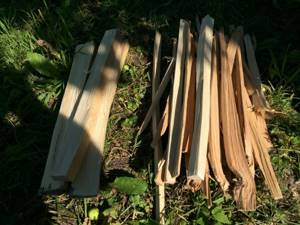
Source: Fishki.net
How to choose the right spices?
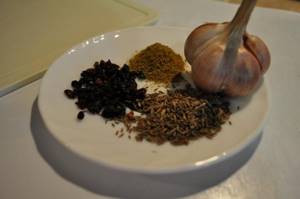
It is impossible to give a complete description of what zirvak is without mentioning the spices that make pilaf so aromatic and tasty. The most important spice in this dish is considered to be cumin. The seeds of this plant are used in cooking. To check whether the purchased cumin is counterfeit, you need to rub the grains between your fingers and feel the aroma.
In addition to cumin, other spices are also added to zirvak (arranged in order of importance after cumin):
- barberry - dried berries of the plant are added to pilaf to neutralize fat and add a piquant sour note;
- garlic – enhances the taste and aroma of the finished dish;
- hot pepper – gives the dish a fiery taste;
- saffron – gives a light, pleasant aroma and golden color.
Due to the high cost of saffron, turmeric is sometimes used when preparing pilaf at home. For 1 kg of rice and meat, it is usually enough to add half a teaspoon.
Pilaf with soy sauce
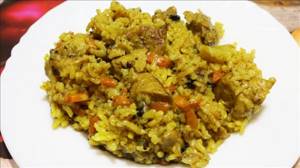
Ingredients:
- Pork pulp - half a kilo.
- Carrots - 2 pcs.
- Onions - 2 pcs.
- Vegetable oil - a quarter cup.
- Garlic - 5 teeth.
- Rice groats - 1.5 cups.
- Spices for pilaf - 1 sachet.
- Soy sauce - 1 table. l.
- Salt - to taste.
- Turmeric, curry - 1 tsp each.
Cut the pork into small pieces. Chop carrots and onions into cubes. Peel the garlic. Rinse the cereal thoroughly. Pour oil into the bowl and heat in the Fry mode. Add onion and carrots and fry for 10 minutes. Then add the meat to the vegetables and fry for another 10 minutes with the lid open. After this, season with spices, pour in soy sauce, fry for about 5 minutes. Do not forget that soy sauce is salty, so you need to add salt carefully. And finally, add the washed cereal, garlic cloves and pour boiling water, exceeding the rice level by 1 cm. Close the multicooker, switch to the Pilaf or Stew function and continue cooking for 40-50 minutes. In some devices the time is already set to 1 hour, so you need to sometimes test the rice to see if it is done. Mix the finished dish and place it on plates or in a heap in one large flat dish. Palov with soy sauce in a slow cooker turns out crumbly and tasty. And this dish simply needs gravy that will highlight its unique taste.
Bon appetit!
Step by step recipe
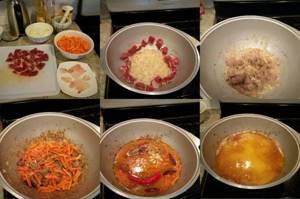
You can learn how to prepare zirvak from the following detailed instructions:
- Heat a cauldron over high heat.
- Cut the fat tail fat into small pieces. Place it in a heated cauldron to render the fat. Reduce the heat to medium.
- Meanwhile, cut the lamb into medium-sized pieces.
- Chop the onion into half rings and the peeled carrots into strips.
- Using a slotted spoon, remove any cracklings from the fat that has melted in the cauldron. Pour vegetable oil into it and heat it well.
- Place half an onion in a cauldron and soak it in the fat until it turns brown, then remove with a slotted spoon. The onion will remove the unpleasant aroma from the oil.
- Place the meat in a cauldron and fry it well on all sides. As soon as the lamb is browned, add onion cut into half rings into the oil.
- After 5 minutes, add carrots. Add salt, pepper, mix.
- Add enough water to cover the entire contents of the cauldron.
- Add cumin (1-2 tsp). Cut off the top or bottom of each head of garlic and place it directly in the peel in a zirvak.
- After 30 minutes, remove the garlic from the cauldron, and instead add barberries and a pod of hot pepper (optional). Simmer the zirvak until cooked for another 20 minutes. After this you can add rice.
Making delicious zirvak
You can make delicious Fergana pilaf only with strict adherence to the rules of stewing and well-selected rice. About rice, we can say that it is better to take arpashaly (fluffy rice, grows in Fergana) or devzira (also Fergana, long-grain with a rounded tip). If such varieties are not available in your nearest store, regular Krasnodar varieties will do.
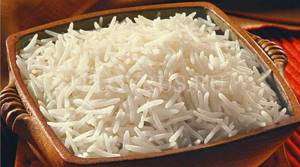
And now the most important thing is to prepare the correct zirvak for Uzbek pilaf. We go to the market and buy good quality products. We cook in a large cauldron and for a large company, so we take one and a half kilograms of rice and, accordingly, products:
- 1.5 kg lamb;
- 1.5 kg yellow or halved or halved orange carrots;
- 0.5 kg of tail fat (or lamb fat);
- a couple of seeds;
- half a bottle of odorless vegetable oil;
- 600 - 1000 g onions;
- 5 large heads of garlic;
- three peppers;
- ground black pepper, salt, barberry, cumin.
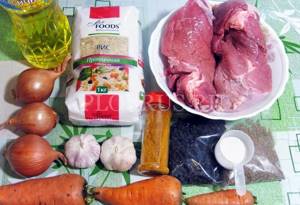
Step-by-step preparation of the correct zirvak
We prepare zirvak like this:
- Heat a cauldron over a fire or gas stove.
- Cut the lard into cubes and place in a cauldron to render the cracklings.
- We cut the meat into small pieces.
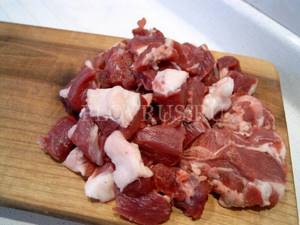
- Peel the onions and carrots and chop them into half rings and strips, respectively.
- Using a slotted spoon, take out the cracklings from the rendered lard and pour in vegetable oil and heat it up.
- Place the bones in the fat and fry over high heat until brown. Let's get it.
- Place half an onion in boiling oil and fat. We keep it until it turns brownish - the onion removes unpleasant aromas from the oil.
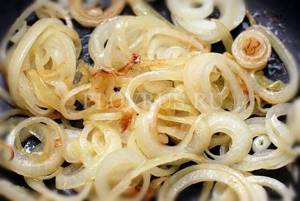
- We take out the onion. Add chopped meat.
- While it's roasting, let's make rice. We wash it in clean water several times, then salt it and soak it in clean filtered water.
- Once the meat is browned, return the bones to it and add the onion cut into half rings. Fry until golden brown.
- Salt and pepper the meat, then add the carrots. Mix everything and fry over high heat for about three minutes, add water to cover the entire contents of the cauldron. Add cumin - a couple of generous pinches.
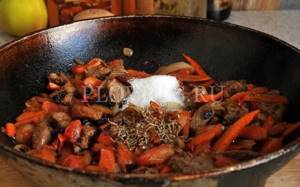
- Cut off the top or the bottom of the garlic and place it in a zirvak, pressing down a little.
Note! It is prepared using different traditional methods of storing meat. Without experience, it is difficult to immediately grasp the moment of laying out the bow. If you put it in early, the meat will be undercooked; if you put it in late, you will dry out the meat, and the onion will be undercooked. Therefore, many people do the opposite technique: first they fry the onion in oil, then take it out and fry the meat in oil until the desired condition.
How long does it take to cook zirvak? Cooking time - 40-50 minutes. Simmer them with garlic for half an hour, then carefully remove the garlic and simmer for another 10-20 minutes. When the zirvak is almost ready, add barberry and mix. Remove the rice from the water, place it on a serving tray and carefully level it out with a slotted spoon. Sprinkle the rice with additional cumin.
Lightly compact and cover with a lid. If necessary, add a couple of fingers of boiling water on top of the rice. Keep the pilaf on the fire for about 50 minutes. Then insert the heads of garlic into the swollen rice, add the pepper, cover with a lid and cook on low heat for another 40 minutes. If necessary, add boiling water. Mix the finished pilaf, first removing the bones and pepper and garlic. Return the heads and peppers to the dish for beauty.
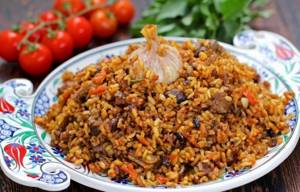
How long does it take to cook zirvak for pilaf?
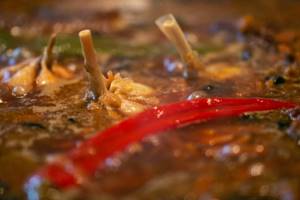
The preparation time for the aromatic gravy of meat, vegetables and spices is 45-50 minutes. But you need to consider what kind of meat is used in the zirvak recipe for pilaf. For example, it will take much less time to cook gravy from chicken than from lamb. In this case, 30 minutes will be enough.
The readiness of zirvak can be determined by taste and visually. A film of fat forms on the surface; there should be no foam. The correct zirvak should be transparent. If the broth turns out cloudy, the rice will absorb all the moisture and become mushy. And this is unacceptable in real pilaf.

